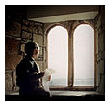One Central Spot of Red
Posted by Anne on Jan 5, 2012 in Writing | 16 commentsRecently, while I was interviewing Andrew Lansdown, he commented he was living proof anyone can learn to write. He claimed that no one could have started out worse than he did. His story drafts were terrible. I laughed and told him I was sure I could still give him a good run for his money.
But, as I’ve reflected on his words, I’ve wondered: can anyone learn to write? Andrew is a poet and as a result I think there’s probably an aspect or two he’s automatically assumed about writing that isn’t necessarily true for everyone.
Most aspiring writers (and sometimes even published ones) seem to believe one of two things:
(1) that great technique—and this includes spelling, grammar, sentence flow, engaging prose, a narrative hook, all the principles of perspective and ‘show, don’t tell’—makes a wonderful book.
(2) that technique is a non–essential—the ideas, the message, the information imparted, the events of the plot (which are subtly different, by the way, to the plot itself) are all–important.
As I receive manuscripts to appraise, I am often struck by the fact that one very critical element is missing in an otherwise excellent text. This ingredient is sometimes missing from my manuscripts, too! George Macdonald said it best: ‘As stories they want the one central spot of red—the wonderful thing which, whether in a…story or a word or a human being—is the life and depth—whether of truth or humour or pathos…that shows the unshowable.’
What stories do you remember? And what makes them memorable? As I asked myself this, I thought of the images, scenes and words from various books that have stayed with me over a lifetime:
read more


